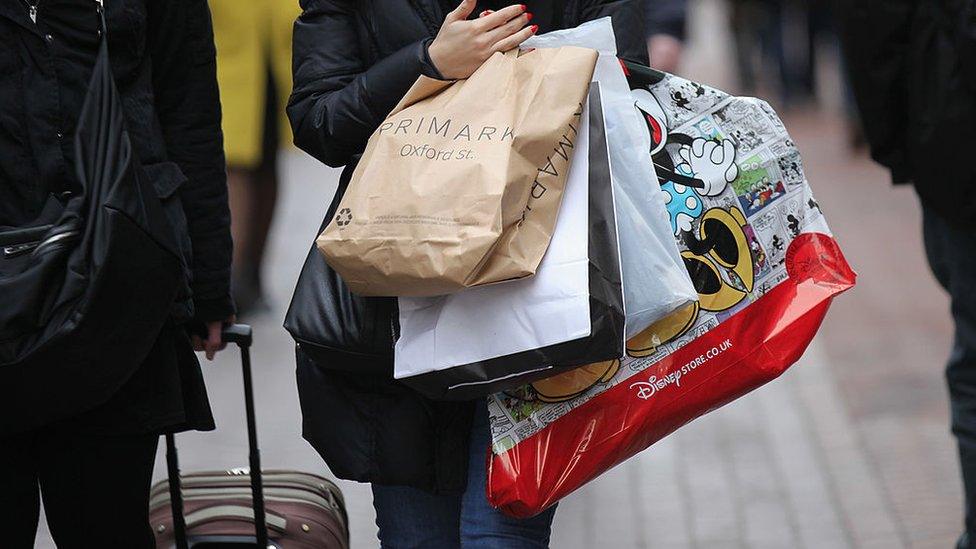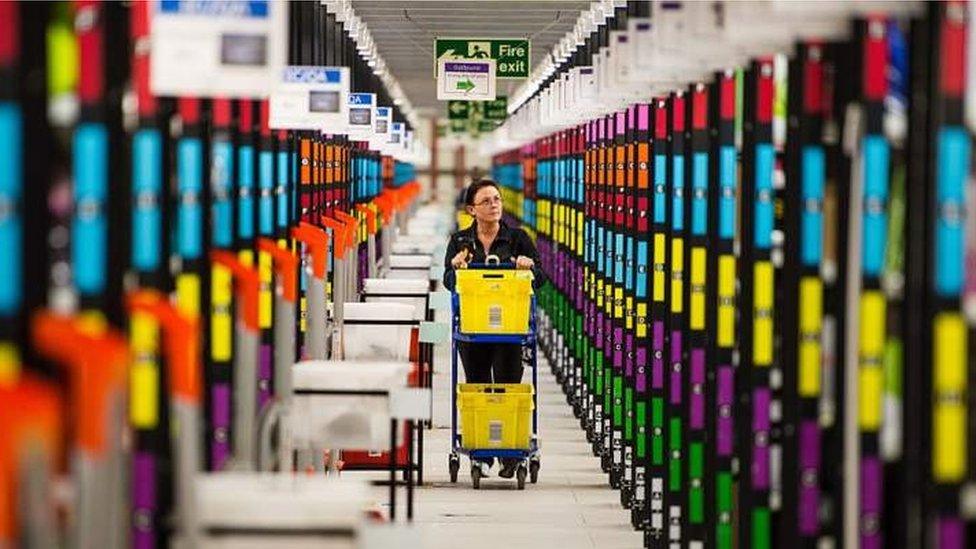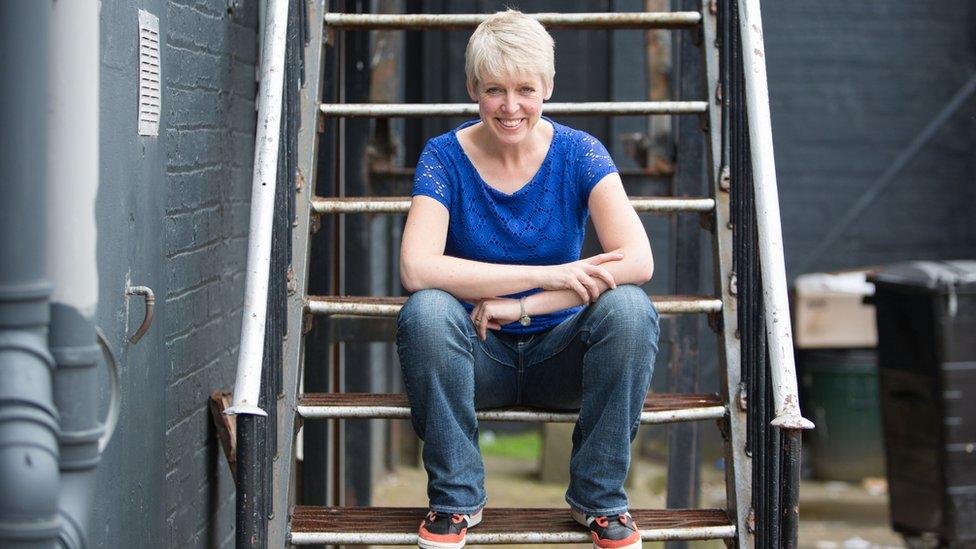The people who return most of what they buy
- Published

Harriet Gordon says clothes don't look the same on her as they do on models
Serial returners, people who buy items and then return them, are on the rise, putting already struggling shops under pressure. But why do people do it and how should shops handle them?
Harriet Gordon, a recruitment consultant in London, reckons she only keeps around half of the clothes she buys online. She spends about £400 each month, but then returns £200 worth of items.
Mainly it's because the clothes don't fit in the way she expected, but often the colour or fabric disappoint, bearing little relation to the online images.
"You see models wearing things and it looks fantastic on them," she laughs, saying they don't look the same on her.
The fact that many of the shops she buys from will collect her returns makes it even easier. Despite working in Covent Garden, which is chock-a-block with shops, the 28-year-old says it's a lot easier to go online than face the queues and stress of shopping in stores.

Hester Grainger returns almost everything she buys
It's a similar story for Hester Grainger. For an upcoming wedding the 41-year-old ordered seven dresses from online retailer Asos. She knew she'd only keep one, but wanted to make sure she got the right one.
When she needed new jeans, she did the same, ordering five pairs while only ever intending to keep one.
In total, she estimates she spends between £300 to £400 each month on clothes, but returns so much that her actual spend is around £70 to £80.
"I am pretty bad," she laughs. "I spend several hundred pounds on different purchases from different retailers over the course of a month, but I probably return about 80% of what I buy."
Hester, the founder of online mums' network Mumala Club, says she shops like this partly because she's short. At 5ft (1.52m), it's hard for her to know how something will fit, meaning she often orders the same item in three sizes.
Shoppers like Harriet and Hester are not unusual, but pose an increasing challenge for retailers.

Research shows a person's heart rate goes up when they buy something
Recent figures from Barclaycard, external, which sees nearly half of the nation's credit and debit card transactions, say a quarter of retailers have seen returns increase over the past two years.
For online clothes and footwear shops, almost half of what consumers spend ends up being returned.
Social media is helping to fuel the trend with around 10% of shoppers confessing to taking a photo of themselves in a new item to post on Instagram or Facebook and then swiftly sending it back.
Free thrills
Geoff Beattie, a psychology professor at Edge Hill University, says it's surprising the rate of returns isn't even higher.
His research shows that a person's heart rate goes up when they buy something. This buzz lasts through taking an item home and showing it off, but then quickly wears off and we regret the money we've spent, or the fact that we won't wear the item much. Hence we return it, he says.
"What happens next is the least exciting part of the process. If you're a returner, you get all that excitement for nothing."

Hester says the fact she is 5ft makes online shopping even trickier
The rise of online shopping has accelerated the trend because there's "no shame or embarrassment" or a need to explain why you no longer want the item, Prof Beattie says.
Heavily promoted discount days, such as the recent Black Friday and Cyber Monday sales, which encourage panic purchases, are even more likely to lead to buyer's remorse.
Processing and handling the returns can hit shops' profits. It's not just the delivery costs, but packaging and cleaning. It's also time consuming.
If an item you want is not in stock it may be because it's stuck in the returns cycle. To avoid this some shops order more stock than they expect to sell, adding to their costs.
Another problem for clothing chains is the fast fashion cycle. By the time an item is returned it's sometimes already on sale, meaning the shop can no longer sell it at full price.
According to Barclaycard, a third of retailers have hiked their prices to cover the cost of returns.

Amazon is reported to have barred some serial returners
Up until now, shops desperate to secure a sale have made it incredibly easy for customers to return items, typically not charging a fee for the service and in some cases, offering a "try before you buy" scheme, so you only pay for the item if you keep it.
Inevitably the system is open to abuse. Many people, for example, order extra items they have no intention of keeping just to qualify for the free delivery threshold.
Serial abusers
But some retailers are now fighting back against the worst offenders. Online giant Amazon, for example, was reported to have started barring customers who had returned too many items.
"We want everyone to be able to use Amazon, but there are rare occasions where someone abuses our service over an extended period of time," a company spokesman told the Wall Street Journal.
Whatever Amazon does other retailers are likely to be tempted to follow.
A recent study by retail management system Brightpearl, external found over half of UK fashion and clothing retailers would consider banning serial returners.

Vicky Brock says serial returners aren't bad customers
But Vicky Brock, director of data innovation at ReBound Returns, a returns management software system, says it's wrong to assume serial returners are bad customers. She says a small proportion of shoppers will generate the majority of returns, but this group will contain both a shop's best and worst customers.
"Placing a ban on shoppers for repeatedly returning items overlooks the individual customer's lifetime value and reveals that the retailer actually doesn't understand their shoppers' return behaviour well enough," she says.
Data shows that the more orders customers make over time, the lower their refunds become per order as they get better at getting it right.
Providing better images of clothing online and more accurate and consistent sizing is one of the ways shops can try to reduce return rates, say experts. Some companies such as Uniqlo and Asos already provide a suggested size based on customers' previous purchases and information on height and weight
Other ways are to target marketing to individuals. So if a customer tends to keep trousers, but always returns shoes, targeting them with trouser adverts, for example.
Ultimately, Ms Brock says, returns are now as much a part of the shopping experience as buying things and shops need to act accordingly.
Hester says she has no intention of changing her behaviour. "I won't feel too sorry for the retailers. They're part of the problem as they offer free or cheap delivery. They need to get their sizing right," she says.

Your consumer rights

High Street shops don't have to accept a return, although many shops do offer a refund or exchange policy. If an item you buy is damaged then you are entitled to a full refund for up to 30 days.
But when you buy goods online you have additional rights to return. This is because your decision may be based on a brief description or a photograph, so what you receive is not always quite what you had expected.
You have the right to a 14-day cooling-off period from the date you receive the goods. You then have a further 14 days to return the goods, with the right to a full refund.
However, this doesn't apply in some situations, for example if the goods were personalised for you, were perishable, or are not in the same condition as when they were delivered.
